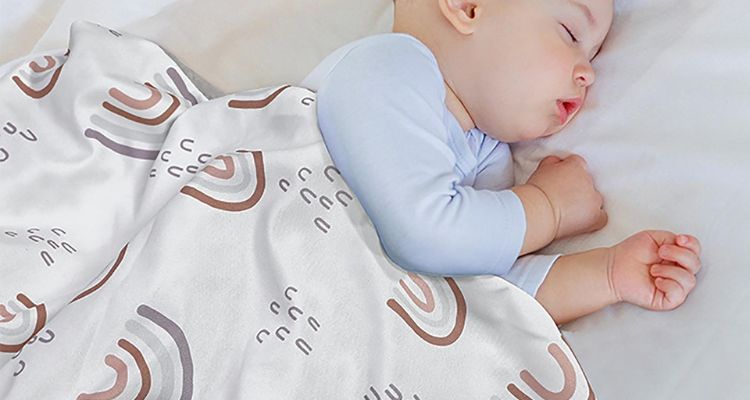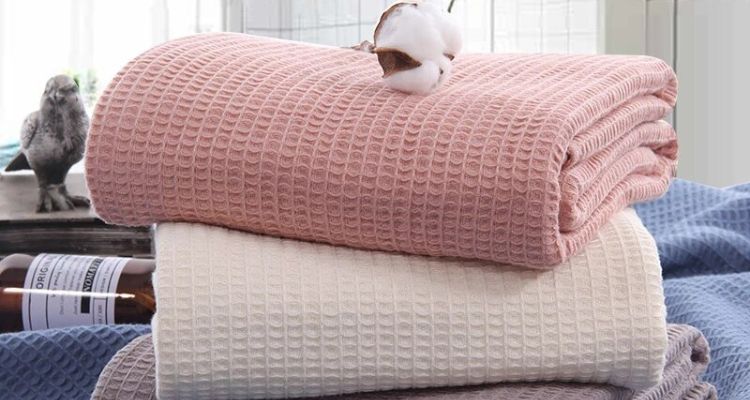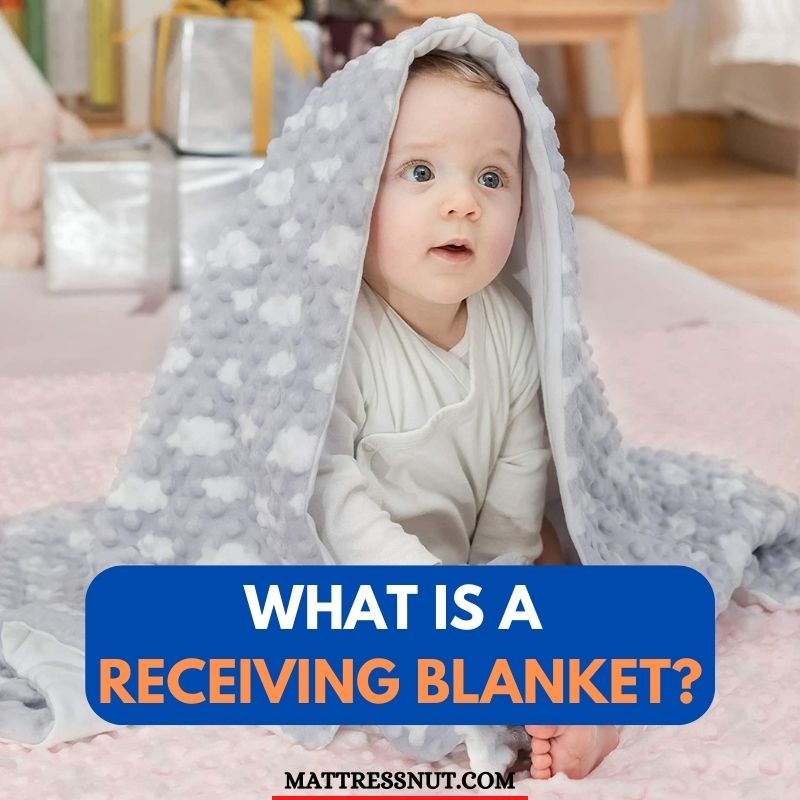For anyone who doesn’t know what a receiving blanket is, it’s a blanket for wrapping an infant after bathing. It’s an effective way to keep your little one warm and provide a small play area. Being lightweight, these blankets are breathable, and your little angels feel nice and relaxed.
Now, you might be familiar with such blankets with another name called swaddling blankets. But they are slightly different, and we will discuss them in detail in this guide. So, let’s dive right in, shall we?
Difference between Receiving Blanket and Swaddling Blanket
First, we need to discuss the difference between receiving and a swaddling blanket. These blankets achieve the same purpose; to keep your little angel warm. The difference comes in their design.

Receiving blankets tend to be rectangular or square in shape and design, while swaddle blankets have a much smaller shape, and two sides in wing shape can comfortably swaddle your little one.
There is another term called muslin blankets, which are slightly bigger than receiving blankets. There is no difference from receiving blankets other than that they are made of muslin, plain-woven cotton fabric.
Moreover, receiving blankets tend to be thicker than swaddling blankets, which are more comfortable for your little ones and ideal for warmer climates.
Being thicker, receiving blankets are more durable and slightly smaller to wrap the newborns. On the other hand, swaddling blankets are made to stretch and wrap your baby and are available in different sizes. Some of them even come with velcro.
Receiving blankets are more versatile than swaddling blankets. They are for temperature control, while swaddling blankets prevent the babies from startling themselves and keep them calm when they move randomly while asleep.
How Can You Use Receiving Blankets?
These receiving blankets are pretty good for the first time after bathing a newborn. Be sure you understand what other purposes they can serve. When your little one is young, these receiving blankets tend to be suitable for a variety of purposes,
Swaddling
These blankets are great for swaddling; you can use them in the hospital to wrap your wiggly newborn. They will come in pretty handy to calm down your young one.
Wrapping after a bath
You can use these blankets for wrapping your little angel after a bath. These blankets are made of gentle materials that can help retain body heat after a bath.
Making a stroller cover
You can use these blankets and make them as a stroller cover to protect your little one from sun or rain. Therefore, you always need to keep a blanket in your stroller basket in case you need one.
Privacy for nursing
These blankets can come in handy when breastfeeding your little bundle of joy. You can use them to clean up any dribbles or spits.
Mats for changing diapers
If you are not using any changing tables, especially somewhere in a public bathroom and want to protect your baby from a messy diaper, you can use these blankets to create a cleaner changing space.
Using them as play mats
These blankets can come in handy at home as you can use them as play mats. You can use them when visiting a park or your friend’s place.
Handy for messy eaters
Some little ones come with extraordinary spitting-up skills. To tackle such projectile spit-ups, you can use these larger blankets.
A bond of love and security
You will see that your little one will develop a bond with their blanket and feel much more comfortable when wrapped in it.
Turning these blankets into pillows, quilts, or stuffed toys
You can use these blankets and turn them into pillows, stuffed toys, or quilts for your little mess, just like some sentimental mementos. You can even ask for help if you are not crafty enough yourself.
Mess catchers during your kids’ stomach bug
To keep those inevitable cleanups much easier, you can use these receiving blankets and set up your bed or a couch where your kids can make all the mess.
Keep them in your car
Babies have no boundaries or limits when they make a mess. So, your car is not immune to all of it. Therefore, you can keep a receiving blanket in your car to deal with any sudden messes on the go.
What Size is a Receiving Blanket?
The standard size of a receiving blanket is around 28 inches by 34 inches (70cm x 86cm). At the same time, a standard square shape receiving blanket measures 30-inch or 76 cm in size. There is a wide range of other sizes also available. You can pick one according to your needs and requirements.
Swaddle blankets are larger and can be 40-inch or 48-inch in a square. You can find preemie blankets around the size of a receiving blanket, but they are more colorful. Baby quilts can be around 36-inch square and go as large as 45-inch x 60-inch.
Crib blankets are around the same size, while stroller blankets are around 30-inch x 40-inch. There are a wide variety of other coverings as well, including the likes of toddler blankets, lovey blankets, security blankets, and car seat blankets
We have provided you with the size details here so that you don’t buy the wrong type of blanket for your little one.
How Many Receiving Blankets Do I Need?
It’s good to have 4-6 receiving blankets. Once a blanket gets dirty you can quickly replace it with a new one and put the dirty one into the laundry. After going through numerous laundry rounds, these blankets fade and lose their shape to some extent. Each of these blankets lasts around 15 washes; after that, it’s either lost or thrown out.
Hospitals don’t have any policy to give blankets to families. So it’s good to have at least 4-receiving blankets.
What Material is Best for Receiving Blankets?
These receiving blankets are available in different materials, and you need to pick one based on the sensitive skin of your little one. The material should be breathable, so here are a few fabric types for you to consider.
Cotton
Organic cotton would be a good choice here because it is made without any fertilizers and pesticides. It’s a top choice for your little ones and adults with sensitive skin types. It’s breathable, lightweight, and a top voice for children’s clothing and receiving blankets.

Cotton-Jersey Knitting
This material is an extended cotton fabric type with some additional jersey features. This fabric doesn’t pile and is highly stretchable, so it’s a top choice for waddle blankets. But the edges tend to curl up after washing.
Flannel
It is made of cotton and is highly durable and soft. However, flannel does tend to become softer with every wash. The softest variant of flannel is made of 100 percent cotton, and it’s a good option for colder climates.
Bamboo rayon
Rayon is highly breathable and soft and is stretchable. Therefore, it works better for swaddle blankets. This fabric is a good option for warmer climates, and it also comes with antibacterial properties. So, for excellent temperature regulation and with its hypoallergenic properties, this fabric is a top choice for receiving blankets.
Fleece
Fleece is another great option for warmer climates because it has excellent warming capabilities. It is extremely soft and can resist stains. Therefore, it is much simpler to wash, and you won’t have to make much effort to dry it. It is an ideal option for the sensitive skin of your baby.
Wool
This stuff is not very popular in warmer climates, but it does come with thermoregulation and moisture-wicking properties.
But there is a slight disadvantage: some skin types find wool a bit scratchy, particularly wool with thicker fiber. Thinner wool fibers are better for their wide range of benefits.
Do Hospitals Reuse Receive Blankets?
You might have seen that fabric elsewhere and wondered if hospitals reuse these receiving blankets. These white flannel blankets with blue or pink stripes are common in hospital delivery throughout the country.
It is one of the first fabrics to touch your little one’s skin and that of many other little angels. Well, according to a Nurse at Advocate Condell Medical Center located in Libertyville, Illinois, her hospital has been stocking the same blankets for the past 2 decades when she started working there.
She has added that these blankets are great to wash, highly durable, and absorb pretty well. These blankets have been developed by Medline, which is a medical supply manufacturer located in Mundelein, Illinois.
In the earlier days, these blankets were developed in the US, but the production has moved overseas. The entire focus here is to cut costs.
When should you stop swaddling with a receiving blanket?
Most experts recommend stopping swaddling with a receiving blanket once your baby starts showing signs of trying to roll over, which is usually around 2-3 months. At this point, swaddling can become unsafe as it restricts your baby’s arm movements. Look for cues like your baby trying to push up on their arms or breaking out of the swaddle.
Can I use a receiving blanket as a burp cloth?
Yes, receiving blankets can double as burp cloths. They are very absorbent and have a soft texture that is gentle on a baby’s skin. Just be aware that using it as a burp cloth may cause it to become stained over time. You may want to designate a few receiving blankets specifically for burping and keep others cleaner for wrapping and swaddling.
Conclusion:
Receiving blankets can come in handy, and use them for many purposes. Thanks to their durable construction, these blankets are pretty long-lasting.
They are available in a wide range of colors and fabrics. Just make sure to give your little one the most breathable and absorbent. It will help your baby to rest well and keep them safe after their first bath.
References
https://www.aap.org/en/news-room/news-releases/aap/2022/american-academy-of-pediatrics-updates-safe-sleep-recommendations-back-is-best/
https://www.npr.org/2011/07/22/138575125/born-in-the-usa-this-blanket-might-look-familiar
https://pubmed.ncbi.nlm.nih.gov/28394766/
Receiving blanket FAQs
At what age do you stop using these receiving blankets?
You should stop using a receiving blanket once it's time to use swaddle blankets for the little one, which is around 1 to 2 months old. You should stop swaddling your little one when they begin rolling over, which is around 2 to 4 months old.
Are muslin blankets the same as receiving blankets?
Yes, muslin blankets are very much similar to receiving blankets. The only difference is their slightly larger size and that they are made of muslin fabric, a type of cotton. Apart from that, there is no difference between these two types of blankets.
Can you bring your receiving blanket?
Hospitals tend to provide their own receiving blankets for the little ones. But if you don't want to go for those blankets, you can always bring your receiving blanket and take your newborn in them for the ride home. Just be sure to make the blanket a heavier one if the weather is cold.
Do you need those receiving blankets?
Yes, you do need these receiving blankets. If you don't want to use the one your hospital gives, you can always bring in your own. But your newborn needs protection after their first bathing soap. Receiving a blanket is a must for their safety.
When can a baby sleep with a receiving blanket?
According to the American Academy of Pediatrics, it's not safe for your little one to sleep in a blanket, especially when they are less than a year old.
This is because wrapping the theme in this blanket might cause suffocation and SIDS. Therefore, you should not place these blankets, other pillows, or stuffed animals with your little one.

